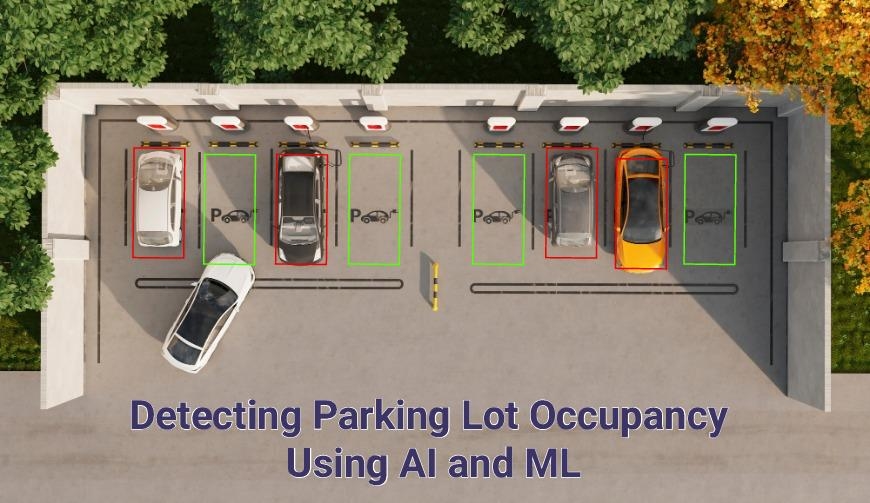
Machine Learning and Artificial Intelligence can help to solve high complexity problems, such as the solution of transportation problems. As we all know there is a huge waste of parking spaces everywhere on the planet as people drive around looking for parking. This problem will become even greater as the world population continues to grow and as more and more people move to cities. On average, 28% of the space of every city block is used for cars parked at any given moment. Parking spaces can take up as much as 40% of city land-use if they are not blocked off. In this blog, we will explain parking occupancy detection using Artificial Intelligence and Machine Learning.
Reports and Data says Automated parking system (APS) market was valued at USD 1,519.4 Million in 2020 and is projected to witness a growth of 12.40%of CAGR during the forecast period (from 2020-2028).
Finding a vacant slot is important. We need to know which slots are vacant for a number of reasons. If a car is parked at a particular slot, we can use it as a vehicle for testing high-frequency WiFi applications. A little more subtly, it’s often the case that most cars are parked most of the time and each car can be used as an access point with its own software radio. In crowded parking lots, this kind of approach doubles the number of available network nodes.
Detecting Parking Lot Occupancy Using AI and ML
- Detecting a Parking Slot with Computer Vision
- Detecting Parking Slots using Deep learning
- Detecting Parking Slots for Electric Vehicles
Detecting a Parking Slot with Computer Vision
We can detect a parking slot using computer vision, a subfield of Artificial Intelligence, which speeds up the parking procedure and reduces traffic congestion, as well as help cars to position in parking lots. Furthermore, many cars come with an Around View Monitor, which aids drivers in observing other vehicles. As a result, the system has a realistic technique to detect parking slots nearby using existing vehicle cameras.
They detect parking slots based solely on the color of the marks on the parking slot. To improve accuracy, line-based approaches are employed, which first detect markings on the parking slot, then fit a straight line to generate a parking slot based on the geometric data of the parking slot.
For greater precision, systems employ the Harris corner detector, which detects corners in panoramic images and integrates them into multiple junctions to generate a parking slot, which is then assigned to a car based on geometric parameters.
Experts switched parking slot detection to directed entrance line regression and classification to solve several limitations of earlier parking models. This allows us to identify a large number of parking spaces. We may design the direction, length, position, and kind of entrance line using a one-stage object detecting algorithm.
Using geometric data, we can obtain parking slot data based on the result of this model. Several experiments are carried out to evaluate this model. The results show that the model is very efficient and can detect a variety of parking slots, such as vertical, parallel, and slanted parking slots.
Source : Frontiersin
Detecting Parking Slots using Deep learning
By integrating NVIDIA GeForce GTX 1080Ti GPUs with Tensorflow’s cuDNN-accelerated deep learning framework. For detecting cars and boundaries, the NVIDIA team trained a convolution neural network on millions of videos and images from diverse datasets, including the COCO dataset. The technology can easily detect free parking places when it has been trained.
The method uses NVIDIA GeForce GTX 1080Ti GPUs for more precise results. For designing the system with a new parking facility, the boundary lines of the parking lot and nearby road sections are marked here.
The system uses a lot of data, previous trends, and other historical data about cars entering and leaving parking slots to filter many characteristic color features, type (which could be a taxi, delivery truck, or other),
when compared to image-based systems and modern commercial systems that rely on pricey sensors, the NVIDIA system is extremely accurate.
Source : NVIDIA
Detecting Parking Slots for Electric Vehicles
Parking electric vehicles with ease and at low cost is a concern. We have been using Artificial Intelligence to assist parking. Here we proposed a solution for optimizing the utilization of parking slots. Using Neural Network, and historical data from sensors on parked vehicles to automatically guide drivers into available spaces. This solution aims to eliminate parking lot congestion by automatically adjusting the available space as needed. We believe this has many practical applications not limited to parking lots and can be used in many other real-world situations as well as conceptual research work. In a recent market study by Global Industry Analysts says Global Robotic Parking Systems Market to Reach $165.9 Million by 2026
Source: Global Robotic Parking Systems Market
In another model, keeping track of parking spaces and charging facilities for electric vehicles is a difficult task. For communication, the parking detection system is linked to charging stations. This approach is used to detect automobiles that are parked in EV charging slots but are not looking to charge so that the slot can be blocked for incoming EV vehicles. For example, the same parking concept is in place in Warsaw, Poland, to assist EV vehicles in finding parking spaces with charging stations.
Source : Parking Detection
Conclusion
As the world’s population continues to expand, there is a growing need for smart parking solutions that provide safe and efficient recharging infrastructure for fleets of electric vehicles (EV) and normal cars. To meet this demand, innovative businesses in many countries are using technology to effectively distribute cars across available parking spaces. By applying Artificial Intelligence in areas such as vehicle allocation in parking lots and coordination of charging behavior, they are improving both overall energy efficiency and EV adoption at scale.
We at Visionify designed Computer Vision Solutions based on image classification systems, for the purpose of image search. It’s an innovative approach to easily find any picture on the web, by automatically classifying it into collections. The technology behind our search engine is based entirely on intricate Machine Learning algorithms that are powered by data mining techniques.

